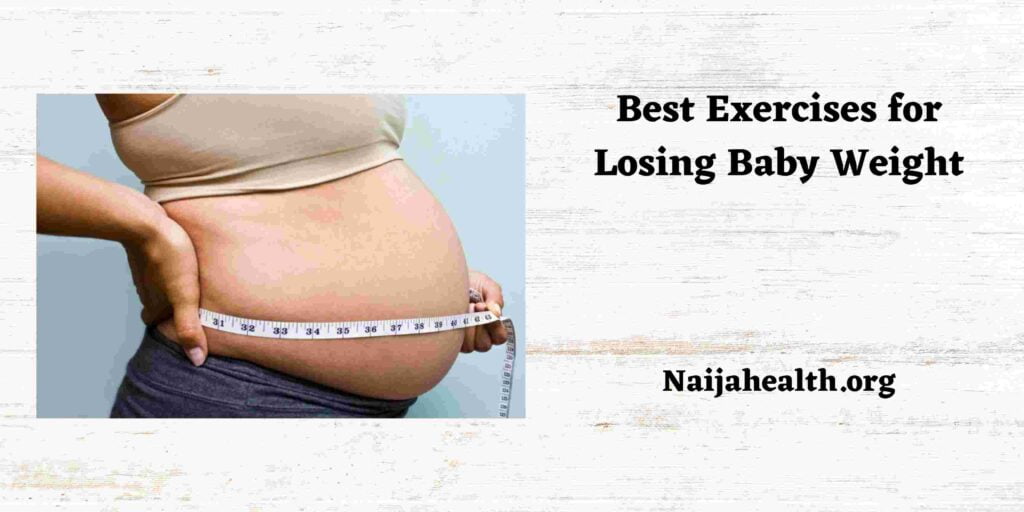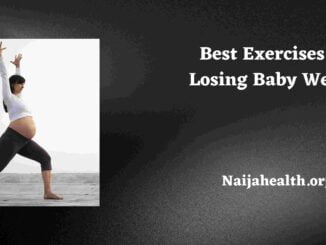
Best Exercises for Losing Baby Weight
After the joyous experience of having a baby, many new mothers find themselves faced with the challenge of losing weight during pregnancy. Postpartum weight loss is a common concern for women as they strive to get back into their pre-pregnancy shape and improve their overall health and well-being.
However, shedding that extra weight can be a complex and demanding process, often with unique challenges.
In the following sections of this article, we will explore different exercises that can help new mothers lose weight safely and effectively. By addressing the specific challenges of postpartum weight loss and providing practical solutions, we aim to support women on their journey back to health and fitness after childbirth.
8 Exercises for Losing Baby Weight
Here are eight exercises that can be effective in losing weight for your baby, along with brief instructions on how to do them:
- Walking
- Start at a comfortable pace and gradually increase your speed.
- Walk for at least 30 minutes a day at a steady pace.
- If possible, make walking part of your daily routine by taking your baby for a walk in the stroller.
- Squat
- Stand with feet shoulder width apart.
- Lower your body by bending your knees and pushing your hips back as if you were sitting in a chair.
- Keep your chest up and put your weight on your heels.
- Stand up to the starting position and repeat a set 10 to 15 times.
- Lunges
- Stand with feet hip-width apart.
- Take a step forward with your right foot, bending both knees to lower your body.
- Keep the front knee just above the ankle and the back knee slightly above the floor.
- Push through your front heel to return to the starting position.
- Switch legs and do 10-15 reps for each leg.
- Plank
- Start in a push-up position, with your hands just below your shoulders.
- Work your abs and keep your body in a straight line from head to toe.
- Hold for 20-30 seconds, gradually increasing the time as you get stronger.
- If necessary, modify by dropping onto your forearm instead of your hand.
- Bridge
- Lie on your back, knees bent and feet flat on the floor.
- Focus on your abs and glutes, then lift your hips off the floor until your body forms a straight line.
- Hold the position for a few seconds and then slowly lower your hips to the floor.
- Repeat a set 10-15 times.
- Push-ups
- Start in a plank position, hands slightly wider than shoulders.
- Lower your body by bending your elbows while keeping your back straight.
- Push back to the starting position.
- Modify by doing knee push-ups if necessary. – Aim for 8-12 reps.
- Kegel exercises
- Kegel exercises help strengthen the pelvic floor muscles.
- Tighten the muscles that you will use to stop the flow of urine or prevent gas from passing.
- Hold the contraction for a few seconds and then release. Repeat 10 to 15 times, gradually increasing the duration of contractions.
- Cardio interval (e.g. jogging in place, jumping rope)
- Choose a cardio exercise that’s right for your fitness level.
- Do the exercise at a moderate intensity for 30 to 60 seconds.
- Follow it with short intervals of 10-15 seconds.
- Repeat the cycle for 10-15 minutes, gradually increasing the duration as your condition improves.
Importance of Exercise in Losing Baby Weight
Exercise plays an important role in losing weight for your baby and staying in shape after birth.
Here are some key reasons why exercise is important for baby weight loss:
- Burn Calories
Engaging in physical activity helps burn calories, which is essential for weight loss. By creating a calorie deficit (by burning more calories than you consume), you encourage your body to tap into its fat stores, including the excess weight gained during pregnancy.
- Boost metabolism
Regular exercise, especially weight training, can increase your metabolic rate. Building lean muscle mass through resistance exercise boosts your basal metabolic rate (BMR), which helps burn calories more efficiently even at rest. This can contribute to steady weight loss over time.
- Fat loss and body composition
Exercise, especially a combination of cardio and strength training, helps reduce body fat and improve body composition. As you lose fat and gain muscle, your body becomes more toned and toned, leading to a healthier and more desirable physique.
- Improved weight loss results
Exercise can complement a healthy diet by improving weight loss results. Combined with a balanced, nutrient-rich diet, regular physical activity can speed weight loss and help you reach your goals more effectively.
- Postpartum hormonal balance
Exercise has been shown to have a positive effect on hormone regulation, including insulin, cortisol, and thyroid hormones. These hormones play a role in metabolism, appetite control, and energy balance. By exercising, you can support hormonal balance, helping with weight loss.
- Increase energy level
It sounds counter-intuitive, but regular exercise can actually boost your energy levels. Postpartum fatigue is common, but incorporating physical activity into your routine stimulates endorphin production and improves blood circulation, leading to increased energy and overall vitality.
- Mental comfort
Exercise is not only beneficial for physical health, but it is also good for mental and emotional well-being. Physical activity releases endorphins, which are natural mood enhancers. It can reduce stress, anxiety and symptoms of postpartum depression, helping you maintain a positive mindset on your weight loss journey.
- Long-term health benefits
Losing baby weight through exercise is not only about getting a certain look, but also about improving overall health and reducing the risk of chronic disease. Regular physical activity has many long-term health benefits, including better heart health, stronger bones, stronger immune function, and a reduced risk of diseases like type 2 and type 2 diabetes. number of cancers.
Safety Precautions for Losing Baby Weight
When starting your weight loss journey after having a baby, it’s important to prioritize safety and take certain precautions to protect your health. Here are some important safety precautions to consider:
- Consult your healthcare provider
Before starting any exercise or weight loss program, consult your healthcare provider. They can assess your overall health, assess any postpartum problems or complications, and make personalized recommendations based on your specific needs.
- Gradual progression
Make your exercise routine easier and gradually increase the intensity, duration, and frequency of your workouts. Respect your body’s postpartum recovery and give yourself time to rebuild strength and stamina. Start with low-impact exercises and gradually incorporate higher-impact activities.
- Listen to your body
Pay attention to how your body feels during and after exercise. If you experience pain, dizziness, shortness of breath, or any other unusual symptoms, stop exercising and see your healthcare provider. Don’t overdo it and ignore the warning signs. It’s essential to find the right balance between challenging yourself and respecting your body’s limits.
- Pelvic floor considerations
Pregnancy and childbirth can weaken the pelvic floor muscles. It’s important to do exercises that strengthen these muscles, such as Kegels, while avoiding high-impact activities that can put undue pressure on the pelvic floor. If you have rectal metastases (separated abdominal muscles), see your physiotherapist for appropriate exercises and adjustments.
- Correct form and technique
Maintain proper form and technique during exercises to avoid injury and maximize effectiveness. If you’re unsure of the correct form, consider working with a trained fitness professional who can guide you through the exercises and make sure you’re doing them safely.
- Rehydration and nutrition
Stay hydrated before, during and after your workout. Drink water regularly to replace fluids lost through sweating. Additionally, maintain a balanced diet that provides adequate nutrition to support your weight loss and postpartum recovery goals. Consult a registered dietitian for personalized advice.
- Rest and recovery
Give your body enough time to rest and recover between workouts. Adequate rest is important for muscle repair, injury prevention, and overall health. Avoid overtraining and listen to your body’s signals when it’s time to rest. Incorporate rest days into your exercise routine.
- Supported Devices
Wear suitable and supportive workout clothing, including a well-fitting sports bra, comfortable shoes, and clothing that allows free movement. This will help prevent discomfort and provide the support your body needs during your workout.
FAQs
Is it safe to exercise after giving birth?
It is safe to start exercising after giving birth. However, it is important to consult your healthcare provider to make sure that you are physically ready and that there are no specific problems or complications that need to be addressed.
When can I start exercising after a caesarean?
Recovery time after caesarean section can vary. It is essential to consult your healthcare provider to determine when it is safe to start exercising. Usually, you can start light exercise and walking right after surgery, but high-impact exercises may need to be postponed until your body has fully recovered.
How much exercise should I do to lose weight for my baby?
The amount of exercise required to lose weight varies depending on individual factors. You should get at least 150 minutes of moderate-intensity aerobic exercise per week, as well as resistance training twice a week. However, it’s important to start slowly and listen to your body’s signals.
Can breastfeeding affect my weight loss?
Breastfeeding can contribute to postpartum weight loss. It burns calories and helps the uterus return to its pre-pregnancy size. However, the effects of weight loss are different for each woman. It is important to focus on a balanced diet, proper calories and regular physical activity while ensuring adequate nutrition for breastfeeding.
Are there any specific exercises to lose belly fat after giving birth?
While it may not be possible to lose local fat in specific areas, exercises that target the abdominal muscles such as sit-ups and plank variations can help strengthen the core and tone the abs. However, overall weight loss and loss of body fat are achieved through a combination of exercise, healthy eating, and consistency.
Can I exercise if I have rectal prolapse?
If you have rectal prolapse, it’s important to be careful with certain exercises that can make the condition worse. Working with a physiotherapist or postpartum exercise specialist can help you identify the right exercises and adjustments that can strengthen your core without aggravating your symptoms.
How long does it take for your baby to lose weight?
Weight loss time of each person is different. It’s important to approach the weight loss process with patience and focus on long-term habits rather than quick results. Gradual weight loss of 1-2 pounds per week is considered healthy and achievable for most people.
Can I play sports with my child?
Yes, exercising with your kids can be a great way to incorporate physical activity into your routine. Activities like strolling or exercises that involve using your baby as resistance (e.g. lifting while squatting) can be fun and beneficial for you and your baby. Make sure they are safe and comfortable during your workout.
Conclusion
Weight loss is a common concern for many new mothers, and exercise plays an important role in achieving this goal. While travel can present unique challenges, such as physical changes, time constraints, and emotions, a combination of safe and effective exercises can help you lose weight. unwanted weight and improve your general health and well-being.
By gradually increasing the intensity and duration of your workouts, listening to your body’s signals, and seeking advice from your healthcare provider or fitness professional, you can ensure a safe weight loss approach. safe and sustainable after birth. Remember that this process takes time and it’s important that you be patient with yourself and focus on long-term progress rather than quick solutions.


